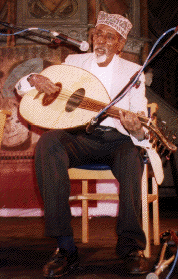
Somali is a Cushitic (and thus Afro-asiatic) language spoken by about nine million people, mainly in Somalia (including the now effectively independent region known as Somaliland), Ethiopia, Djibouti, and Kenya. Standard Somali is based on northern dialects, and is said to be fairly close to the coastal Benaadir dialect of Mogadishu, the capital of Somalia. The course consultant, Fouzia Musse, is a native of Mogadishu. The written standard, created in 1972, uses roman characters.
Available resources include a good reference grammar, several language textbooks, several dictionaries, and many publications on specific topics. Those who plan to participate in 502/202 during spring term 1998 should consider buying Saeed's grammar and the Zorc and Osman dictionary.
A fair amount of written Somali can be found on the net.
Here is
the index of a large site containing many papers in English about Somali
culture, politics and language. In addition, an electronic (text) corpus
annotated (semi-automatically) with morphosyntactic categories has been
offered by its compiler, Doug Biber. It includes some speech transcriptions
as well as written material, and should make it possible to do interesting
studies of focus-marking in Somali.
nin "a man" subject case
nin "a man" absolutive case
L
H
ey "a dog" ey
"dogs"
HL
HH
inan "a boy" absolutive case
inan "a girl" absolutive case
or
H L
L H
"a boy" genitive case
inan "a boy" subject case
L L
Tone is not notated in the orthography, perhaps because it not lexically constant -- that is, a given word will appear in many tonal forms depending on its inflection and context of use. It seems to be an open question whether there are tonal markings in the lexicon: tone is generally predictable from from morphosyntactic context, but only if the "declension" or "conjugation" of a word is known. Here is a fuller description of the tonal properties of nouns. In any event, it seems that there is never more than one LH or HL transition in a word, so that the system has a quasi-accentual character as well.
L L H HL LL
L H H LL LL
H L
hadiyad baa uu ku
u ka keenay Cali
present FOCUS he you for from
brought Ali
"he brought a present for you from Ali"
-->
L L H HL
LL H LL LL
H L
hadiyad buu
kaaga keenay
Cali
Of the seven basic noun declensions, five reverse gender
with plurality (i.e. masculine singular and feminine plural, or vice versa),
a phenomenon known as gender polarity.
There are interesting preverbal clusters of prepositions and pronouns.

Some discussions of Somali verse can be found here,
here, here,
here, here,
here and
here.